Energy Management Policy and Strategies in ASEAN
Volume 9, Issue 4, Page No 102-109, 2024
Author’s Name: Wai Yie Leong 1, Yuan Zhi Leong 2, Wai San Leong 2
View Affiliations
1INTI International University, Persiaran Perdana BBN Putra Nilai, 71800 Nilai, Negeri Sembilan, Malaysia
2Schneider Electric Singapore, 50 Kallang Avenue, Kallang, Singapore
a)whom correspondence should be addressed. E-mail: waiyie@gmail.com
Adv. Sci. Technol. Eng. Syst. J. 9(4), 102-109 (2024); ![]() DOI: 10.25046/aj090411
DOI: 10.25046/aj090411
Keywords: Energy Efficiency, ASEAN, Energy Infrastructure, Renewable Energy
Export Citations
This research analyses the challenges faced by ASEAN countries in managing its energy efficiencies and resources due to rapid economic growth, increasing energy demand, and diverse energy infrastructures across member states. This paper explores the energy management policies and strategies within the ASEAN region, focusing on the integration of energy efficiency measures, renewable energy initiatives, and cross-border energy trade. This paper analyse the region’s progress towards its sustainable energy goals, the role of policy frameworks, and the impact of regional collaboration. Key challenges such as energy security, affordability, and environmental sustainability are examined, alongside opportunities for innovation in energy technologies and policy reforms. The findings highlight the importance of a cohesive energy management strategy that balances the diverse needs of ASEAN member states while advancing the region’s transition towards a low-carbon future. This paper provides policy recommendations aimed at enhancing ASEAN’s energy resilience and supporting its sustainable development goals.
Received: 30 June 2024 Revised: 11 August 2024 Accepted: 14 August 2024 Online: 20 August 2024
1. Introduction
The ASEAN region’s energy demand is growing significantly and rapidly as a result of urbanisation and economic advancement. The ASEAN region’s reliance on fossil fuels, volatile geopolitics, and challenges associated with climate change make it vulnerable to energy supply vulnerabilities.
Consequently, member countries of ASEAN have been working together to develop and implement energy management policies that promote economic development, environmental sustainability, and energy security. The specifics of each ASEAN Member State’s (AMS) energy efficiency (EE) and activities are shown in Figure 1. Remarkably, in the 2030s, Brunei, Singapore and Thailand, declared their intention to cut their Energy Intensity (EI) by 45%, 35%, and 30% [1]. Over the years, AMS has demonstrated a considerable reduction in energy intensity from 2005-2020 and the projected of energy Sumption to 2040 is shown in Figure 2.
In order to improve energy security, regional collaboration is emphasised in the ASEAN energy policy. Member nations cooperate to reduce supply disruptions and guarantee a steady supply of energy for their expanding economies by encouraging cross-border and international energy trade, international networkings, and energy resource sharing (Table I).
The ASEAN energy strategy encourages collaboration on energy-related projects, experience-sharing, financing access, and alliances with foreign organisations, development agencies, and other countries. The energy-related concerns is strengthened by this international cooperation.
The ASEAN energy strategy demonstrates a cooperative dedication to tackling the region’s energy-related issues. The strategy lays the groundwork for member nations to collaborate on energy resources management and create a sustainable energy Future by fostering energy security, resource sustainability, and better economic growth. ASEAN Energy Statistics Leaflet (AESL) 2023 provides comprehensive visualised snapshots of the energy landscape in ASEAN. These include primary energy supply, final energy consumption, electricity, renewable energy, energy-gender, and other energy-related indicators as shown in Figure 3.
2. Literature Review
The heterogeneous region of ASEAN has different energy needs, resources, and obstacles. In light of economic growth and urbanisation, there is an increasing need for energy, making it imperative to create and execute efficient energy management strategies in order to guarantee energy security, sustainability, and resilience. In order to better understand the literature and research on energy management policy in ASEAN, this review will focus on some of the major obstacles, frameworks for policy, and possible solutions.
Challenges in Energy Management: The vast array of problems posed by ASEAN’s heterogeneous energy landscape is noteworthy. Coal, oil, and natural gas are examples of fossil fuels that continue to be major energy sources. These fuels raise difficulties with energy security and the environment. In addition, the region is vulnerable to price changes and geopolitical issues due to its reliance on imported fossil fuels. The necessity of developing sustainable energy sources and diversifying the energy mix is highlighted by this circumstance.
Energy Policies and Frameworks: The ASEAN Plan of Action for Energy Cooperation, or APAEC, is the cornerstone of the region’s energy policy framework. In order to promote energy security, affordability, accessibility, and sustainability, APAEC was founded in 2016. It emphasises how important regional collaboration is to resolving energy-related problems, advancing energy trade within ASEAN, and encouraging energy technology knowledge transfer.
Development of Renewable Energy: As a result of its ability to improve energy security and lessen its negative effects on the environment, renewable energy policies have become more popular among ASEAN members. According to research [2], government initiatives on feed-in tariffs (FiT), incentives, and schemes could facilitate renewable energy technology on wind energy and solar power.
Initiatives for Energy Efficiency: ASEAN’s energy management plans has been increasing energy efficiency. Studies [3] have demonstrated that energy efficiency initiatives aimed at families and businesses have resulted in significant energy savings as shown in Figure 4. These programmes include the creation of energy-efficient appliances, the implementation of best practices, and technological advancements.
Policy Coordination and Implementation: A number of studies highlight how crucial it is for ASEAN member nations to coordinate their policies to guarantee the successful application of energy management plans. Mechanisms to improve energy security and foster economic cooperation have been suggested, including cross-border energy commerce and harmonising energy norms. Policy coordination presents a number of issues that call for constant attention, especially when considering the disparities in national capacities and priorities.
The literature also suggests potential paths that may influence ASEAN’s energy management laws. It has been proposed that the resilience and sustainability of energy systems can be improved by exploring energy technologies like energy storage systems and smart grids. The shift to low-carbon energy systems can also be facilitated by matching energy policies with global climate commitments like the Paris Agreement.
The analysis highlights the intricacy of ASEAN’s energy management policies, involving issues with environmental sustainability, energy security, and policy coherence. It is encouraging to see how far the region has come in creating renewable energy sources and energy-saving techniques. However, to guarantee a safe, sustainable, and resilient energy future, cooperation must continue along with the development of novel tactics and changes to legislation [4].
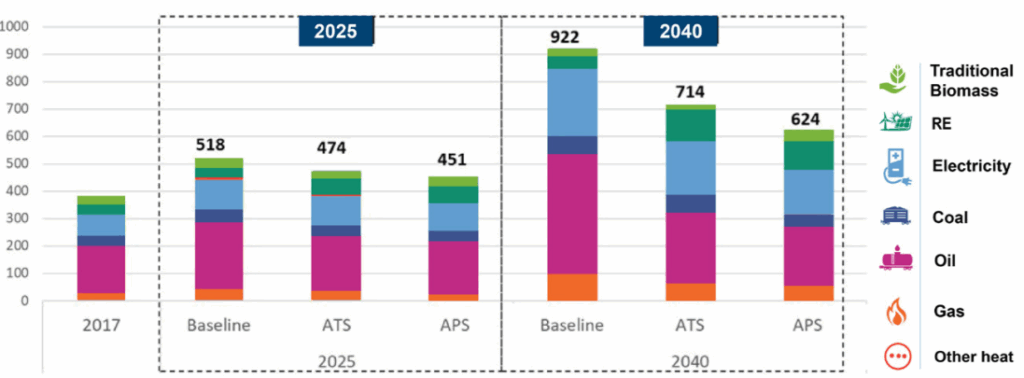
3. Energy Efficiency Policy
The ASEAN region has a wealth of undeveloped renewable resources, but for now, fossil fuels control the majority of the energy systems in the area. ASEAN members aim to attain Net-Zero emissions by 2050 or later in order to combat climate change.
A. Singapore: The country has put in place a number of energy-saving initiatives:
- Energy Conservation Act mandates that major energy users increase their energy efficiency achievement and share on the energy consumption.
- Energy Efficiency National Partnership (EENP) initiative promotes the energy management strategies and energy savings objectives among organisations.
- Building designs and technology that are energy-efficient are promoted by the Green Mark certification programme.
B..Malaysia: The country has implemented energy efficiency policies such as the Energy Efficiency and Conservation Act, which attempts to increase energy efficiency in a number of industries.
- Projects and efforts pertaining to energy efficiency are supported by the Energy Efficiency and Conservation Fund.
- The programme called Malaysian Building Integrated Photovoltaic (MBIPV) promotes the integration of solar energy into buildings.
- Thailand: The country’s energy-saving initiatives include: Encouraging energy-efficient buildings and industry under the Energy Conservation Promotion Act.
- The plan encourages the use of energy-saving technologies and establishes goals for reducing energy intensity.
- Private investment in energy efficiency initiatives is encouraged by the Energy Performance Contracting (EPC) programme.
- Indonesia: The country has implemented many energy efficiency programmes, such as the National Energy Policy, which endeavours to enhance energy efficiency while lowering energy intensity.
- The primary objective of the Energy Conservation Master Plan is to conserve energy in several sectors, including buildings, transportation, and industry.
- Building capacity and energy efficiency projects are supported by the Energy Efficiency and Conservation Programme.
- Vietnam: The country has implemented many energy efficiency efforts, including:
- National Energy Efficiency Programme, which promotes energy-saving measures for public and industrial sectors.
- Energy Efficiency and Conservation Law creates energy labelling regulations and standards for energy-related equipment.
- Energy-efficient building designs are encouraged by the Green Building Certification programme.
- Philippines: The country has enacted several energy-efficient laws, such as the Energy Efficiency and Conservation Act, to encourage energy-efficient technologies in buildings, industry, and transportation.
- The Energy Efficiency and Conservation Roadmap delineates objectives related to energy efficiency and provides a framework for accomplishing them.
- Programme implementation for energy efficiency is managed by the Energy Efficiency and Conservation Division of the Department of Energy.
- Brunei: The energy-efficiency initiatives include:
- The National Energy White Paper lays out plans for enhancing energy-efficiency and advancing renewable energy.
- Targets for lowering energy use and advancing energy-efficient technologies are outlined in the Energy Efficiency Master Plan.
H.Vietnam, Cambodia, Myanmar, and Laos increase energy efficiency with assistance from partners and international organisations. Developing energy-efficient building rules, encouraging energy-efficient lighting, and spreading awareness of energy conservation are some of its endeavours.
It is imperative to acknowledge that these synopses offer a broad outline of energy efficiency regulations in every nation, as illustrated in Figure 3. These policies’ efficacy is contingent upon a number of variables, including public participation, enforcement, and implementation. It is advised to consult government and professional energy related organisations for the information.
4. Strategies for Energy Management Policy in ASEAN
Diversification of Energy Sources: Changing your energy sources is one of the main tactics. Risks to energy security are increased by ASEAN’s significant reliance on fossil fuels. These hazards can be reduced by encouraging the development and use of renewable energy sources, such as solar, wind, hydro, and geothermal. Figure illustrates energy and greenhouse gas emissions in ASEAN.
Improved Energy Economy: Enhancing energy efficiency is yet another essential tactic. Energy-efficient measures can be implemented by member states in a variety of sectors, such as buildings, transportation, and industries. This entails using cutting-edge technologies, encouraging energy-efficient behaviours, and upholding energy efficiency regulations.
Cross-Border Energy Trade: Energy security and dependability can be improved by facilitating cross-border energy trade and linkages among member states. By constructing infrastructure for the transmission of natural gas and electricity, this tactic enables excess energy in one nation to satisfy demand in another. These kinds of partnerships can reduce energy waste and maximise the use of resources.
Technology Innovation and Research: It is imperative to allocate resources towards technology innovation and research. Grid stability and energy management can be enhanced by developments in smart grids, energy saving and storage, and decentralised energy systems. To speed up technical advancements, ASEAN member states might encourage cooperation between academic institutions and business sectors.
Policy Coordination and Harmonisation: The prosperity of the area depends on member governments coordinating their energy policies. Fair competition can be encouraged and level playing fields can be created by harmonising norms, laws, and incentives. To enable cross-border trading of renewable energy, governance rules and key indicator targets for renewable energy can be aligned.
Building Human capability through Training Programmes and Educational Initiatives: Effective policy implementation depends on raising public awareness and fostering human capability. Increasing public knowledge of sustainable methods and energy saving can also encourage behavioural changes and advance energy management objectives.
The solutions presented in this paper provide a way forward for a sustainable, and safe energy, based on the energy issues that ASEAN is currently confronting. Through the adoption of strategies such as energy source diversification, efficiency enhancements, cross-border cooperation, technological innovation, and policy coordination, ASEAN can steer clear of obstacles to achieving its energy objectives and simultaneously support worldwide endeavours to tackle climate change and promote sustainable development [5].
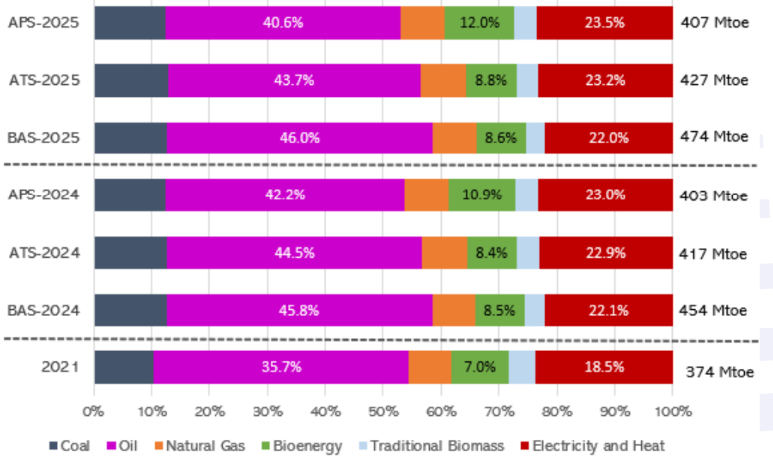
Table I: Energy related pledges by committed by ASEAN countries
| Pledge’s Name | Targets | Countries |
| Global Renewable and Energy Efficiency pledge | Tripling the global’s renewable energy generation capacity to at least 11,000 GW by 2030 and doubling the global average annual rate of energy efficiency improvement from 2% to over 4% per year until 2030 | Brunei Darussalam, Malaysia, Singapore, Thailand |
| Global cooling pledge | Reduce cooling -related emission by a minimum of 68%to 2022 levels by 2050. | Brunei Darussalam, Cambodia, Singapore, Thailand, Vietnam |
| Declaration by Hydrogen and Derivatives | Mutual recognition of certification for renewable and hydrogen | Malaysia, Singapore |
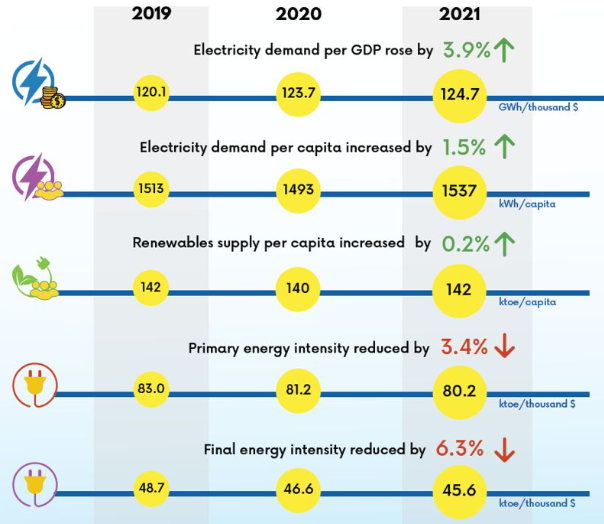
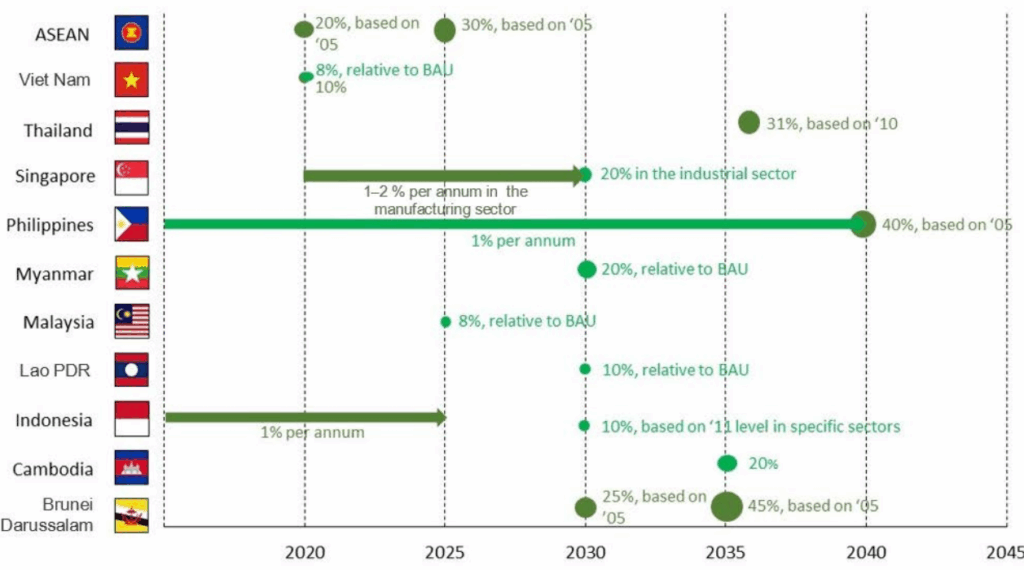
5. ASEAN energy efficiency and policy Collaboration
Future prospects for efficient energy management in ASEAN are quite promising [6]. The region is witnessing economic expansion, urbanisation, and rising energy consumption. Consequently, there are multiple opportunities where energy efficiency and management initiatives might provide significant advantages (Table II):
- The expansion of renewable energy: The ASEAN nations have an abundance of geothermal, hydro, wind, and solar energy resources. Increased utilisation of these resources offers a significant chance to improve energy security, lessen dependency on fuels, and reduce the climate change impacts [7, 8]. Infrastructure for renewable energy on wind turbines and solar energy, can draw investments, diversify the energy mix, and create jobs.
- Smart Grid Implementation: ASEAN’s energy management could undergo a radical change with the implementation of smart grid technologies. Demand response programmes, improved grid stability, optimal energy flow, and real-time monitoring and management of energy distribution are all made possible by smart grids [9]. Smart networks can decrease transmission and distribution losses and increase energy efficiency by incorporating renewable energy sources and strengthening system resilience.
- Energy Efficiency in Buildings: An important portion of ASEAN’s energy consumption comes from the building sector. Significant energy savings can be achieved by enforcing energy-efficient building rules, encouraging green building designs, and implementing technology like energy-efficient heating, cooling, and lighting systems [10]. Another big opportunity is to retrofit existing buildings with energy-efficient systems, as shown in Figure 4.
- Industrial Energy Efficiency: ASEAN’s energy-intensive sectors stand to gain from increased energy efficiency. Energy consumption and production costs can be decreased by using waste heat recovery, energy-efficient machinery, advanced manufacturing techniques, and process optimization [11]. Governments can use legislation and capacity-building initiatives to encourage industries to embrace best practices and technologies.
- Electric Mobility and Transportation: The need for transportation grows along with urbanization [12]. One way to cut greenhouse gas emissions and lessen reliance on imported fossil fuels is to support public transit, establish infrastructure for EV charging, and promote electric vehicles (EVs). A sustainable transportation industry may be facilitated by the combination of renewable energy sources with electric mobility.
- Energy Storage Solutions: The intermittency issues with renewable energy sources can be resolved by integrating energy storage technologies like batteries and pumped hydro storage [13]. In the end, energy storage contributes to a more dependable and resilient energy system by improving grid stability, facilitating the integration of renewable energy sources, and supporting demand-side management initiatives.
- Cross-Border Energy commerce: By connecting the ASEAN nations, cross-border energy commerce may improve energy security and maximise the use of energy resources [14]. Building cross-border transmission lines collaboratively can facilitate the pooling of excess energy and act as a safety net against supply interruptions as shown in Figure 6.
-
Energy and Digitalization Data Analytics: In energy management, digital technology and data analytics have the potential to revolutionise the field [15]. Adoption of sensors, Internet of Things (IoT) devices, and data analytics platforms can facilitate data-driven decision-making for increased energy efficiency, predictive repair of equipment, and real-time monitoring of energy consumption [16].
- Green Finance and Investment: As green finance methods proliferate, funds for sustainable energy initiatives may be drawn to them. ASEAN nations may expedite the shift towards a sustainable and low-carbon energy future by endorsing investments in clean technology, energy-efficient infrastructure, and renewable energy.
-
International Collaboration and information Exchange: To speed up efforts to improve energy management and efficiency, ASEAN nations can take use of international partnerships and information exchange. Countries can adopt successful techniques and benefit from one other’s experiences by exchanging best practices, lessons learned, and successful case studies [16, 17].
In general, there is a great deal of promise for improved energy security, job creation, economic growth, and environmental preservation in the ASEAN countries’ future energy management and efficiency [18, 19]. Through deliberate utilisation of these opportunities, ASEAN nations can set the stage for a future in energy that is both sustainable and affluent [20, 21].
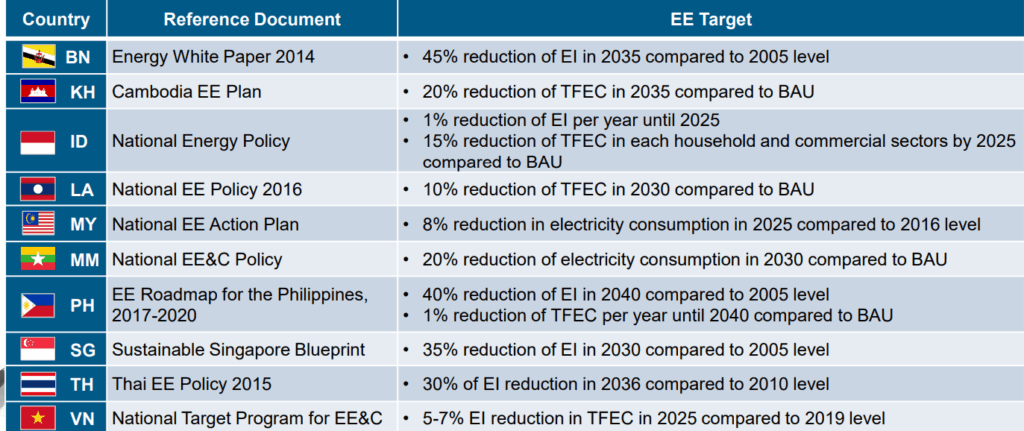
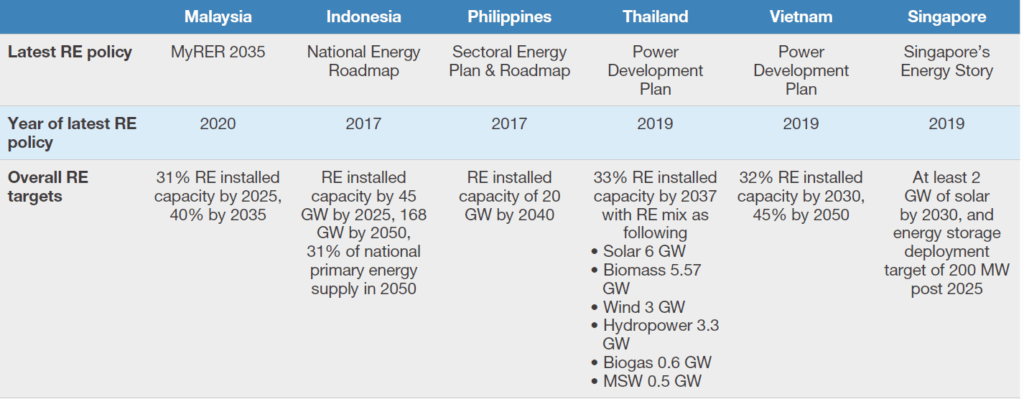
Table II: New and upcoming ASEAN energy policies based on 2023 regulations
| Country | New Policy and Updates Announced in 2023 |
|
Brunei Darussalam
|
|
|
Cambodia
|
|
| Indonesia |
|
| Lao PDR |
|
| Malaysia |
|
| Myanmar |
|
| Philippines |
|
| Singapore |
|
| Thailand |
|
| Vietnam |
|
Conflict of Interest
The authors declare no conflict of interest.
- “ASEAN Energy in 2024: Key Insights about ASEAN Energy Landscape and Predictions in 2024,” ASEAN Centre for Energy, 2024. URL: aseanenergy.org. (Accessed on 9 January 2024).
- ASEANPOST, “5 Energy Companies to Look out for in ASEAN,” ASEANPOST, (Accessed on 9 January 2024). URL: https://theaseanpost.com/article/5-energy-companies-look-out-asean.
- “Energy: AEDS (AESEAN), IEA statistics (EU & Asia Pacific) Economics & Demographic: AEDS (ASEAN), APEC Statistics (Asia Pacific), WDI (EU),” (Accessed by July 2024).
- Gnanasagaran, A.J.T.A.P., “Renewable Energy Cooperation in ASEAN,” The ASEAN Post, 2019. URL: https://theaseanpost.com/article/renewable-energy-cooperation-asean. (Accessed on 1 January 2024).
- Liu, Y., Noor, R., “Energy efficiency in ASEAN: Trends and financing schemes,” ADBI Working Paper Series, No. 1196, Asian Development Bank Institute (ADBI), Tokyo, 2020.
- Leong, W.Y., Kumar, R., “5G Intelligent Transportation Systems for Smart Cities,” In Convergence of IoT, Blockchain, and Computational Intelligence in Smart Cities, Edited by Kumar, R., Jain, V., Leong, W.Y., Teyarachakul, S., 1st Edition, CRC Press, 2023.
- Leong, W.Y., Chuah, J.H., Tee, B.T., The Nine Pillars of Technologies for Industry 4.0, Institution of Engineering and Technology, 2020.
- Leong, W.Y., Human Machine Collaboration and Interaction for Smart Manufacturing: Automation, robotics, sensing, artificial intelligence, 5G, IoTs and Blockchain, Institution of Engineering and Technology, Stevenage, United Kingdom, ISBN10 1839534141, 2022.
- Mehrotra, U., Leong, W.Y., “NSEEAR: A energy adaptive routing protocol for heterogeneous wireless sensor networks,” 2009 35th Annual Conference of IEEE Industrial Electronics, Porto, Portugal, 2647-2652, 2009. DOI: 10.1109/IECON.2009.5415255.
- Leong, W.Y., Leong, Y.Z., Leong, W.S., “Human-Machine Interaction in the Electric Vehicle Battery Industry,” 2024 10th International Conference on Applied System Innovation (ICASI), IEEE, 69-71, 2009.
- Leong, W.Y., Leong, Y.Z., Leong, W.S., “Green Building Initiatives in ASEAN Countries,” 2023 Asia Meeting on Environment and Electrical Engineering (EEE-AM), Hanoi, Vietnam, 1-6, 2023.
- Leong, W.Y., Medical Equipment Engineering: Design, Manufacture and Applications (Healthcare Technologies), The Institution of Engineering and Technology, 2023.
- Lee, W., Liu, W., Chong, P.H., Tay, B.L., Leong, W.Y., “Design of Applications on Ultra-Wideband Real-Time Locating System,” 2009 IEEE ASME International Conference on Advanced Intelligent Mechatronics, 2009.
- Liu, W., Lupito, E., Sum, Y.L., Tay, B., Leong, W.Y., “Ultra wideband antenna for real time location system application,” 2009 35th Annual Conference of IEEE Industrial Electronics, Porto, Portugal, 22738-2742, 2009. DOI: 10.1109/IECON.2009.5415424.
- Leong, W.Y., Homer, J., “Implementing Nonlinear Algorithm in Multimicrophone Signal Processing,” 2005 IEEE Workshop on Machine Learning for Signal Processing, Mystic, CT, USA, 33-39, 2005. DOI: 10.1109/MLSP.2005.1532870.
- Leong, W.Y., “Digital Technology for ASEAN Energy,” 2023 International Conference on Circuit Power and Computing Technologies (ICCPCT), Kollam, India, 1480-1486, 2023. DOI: 10.1109/ICCPCT58313.2023.10244806.
- Leong, W.Y., Heng, L.S., Leong, Y.Z., “Smart City Initiatives in Malaysia and Southeast Asia,” Proceedings of International Conference on Renewable Power Generation, Shanghai, China, 1143-1149, 2023.
- Leong, W.Y., Heng, L.S., Leong, Y.Z., “Malaysia Renewable Energy Policy and Its Impact on Regional Countries,” Proceedings of International Conference on Renewable Power Generation, Shanghai, China, 7-13, 2023.
- Kumar, R., Jain, V., Leong, W.Y., Teyarachakul, S., Convergence of IoT, Blockchain, and Computational Intelligence in Smart Cities, CRC Press, 2023.
- Arshad, A., Yajid, M.A.M., Daroonparvar, M., “Effect of Laser-Glazed Treatment on Thermal Cyclic Behavior of Plasma-Sprayed Lanthanum Zirconate/Yttria-Stabilized Zirconia Double Ceramic Layered on NiCoCrAlYTa-coated Inconel,” Journal of Thermal Spray Technology, 2023. DOI: https://doi.org/10.1007/s11666-023-01662-7.
- Kumar, R., Kapil, A.K., Athavale, V., Leong, W.Y., Touzene, A., “The catalyst for clean and green energy using blockchain technology,” In Modeling for Sustainable Development: A Multidisciplinary Approach, Nova Science Publishers, Inc, 23-39, 2023.
Citations by Dimensions
Citations by PlumX
Crossref Citations
- Wai Yie Leong, Yuan Zhi Leong, Wai San Leong, "Eco-efficient Poultry Farms: Leveraging IoT for Sustainable Production." In 2024 9th International Conference on Applying New Technology in Green Buildings (ATiGB), pp. 432, 2024.
- Wai Yie Leong, Yuan Zhi Leong, Wai San Leong, "Green Policies and Programmes in ASEAN." In 2024 9th International Conference on Applying New Technology in Green Buildings (ATiGB), pp. 422, 2024.
- Wai Yie Leong, Yuan Zhi Leong, Wai San Leong, "Virtual Reality In Green Construction." In 2024 9th International Conference on Applying New Technology in Green Buildings (ATiGB), pp. 449, 2024.
- Wai Yie Leong, Yuan Zhi Leong, Wai San Leong, "Green Energy and Social Impacts for ASEAN." In 2024 9th International Conference on Applying New Technology in Green Buildings (ATiGB), pp. 428, 2024.
No. of Downloads Per Month
